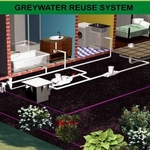 The wastewater stream produced by a household can be divided into
two fractions;
the toilet wastes, commonly called black water, and the other
household wastewater, commonly called greywater.
The wastewater stream produced by a household can be divided into
two fractions;
the toilet wastes, commonly called black water, and the other
household wastewater, commonly called greywater. Greywater contains soaps, detergents, hair, lint and bacteria and other materials which include a wide range of foodstuffs. It is estimated that the proportion of greywater from different house fixtures is 5% bathroom basin, 40 - 80% bath and shower, 10 - 15% kitchen and 5 - 20% from laundry facilities. Untreated greywater, especially kept in storage and heavily contaminated with food particles, cooking oils and grease, would quickly turn septic and emit unpleasant odours, and clog pumps and irrigation systems.
Separating the greywater from blackwater sources is an advantage, as greywater contains less nutrients and is mainly limited to COD and easier to treat using aerobic conditions and biofilms. The quality of greywater effluent primarily depends on the duration of the biological and chemical treatment of the wastewater; that is, the detention time (usually in days) as the greywater is undergoing treatment.
The concentration of nitrogen in greywater is low. For example, only 2 mg/L in a total of 11 mg/L of total Kjeldahl nitrogen in combined wastewater. Fifteen percent of nitrogen in greywater and ninety percent of nitrogen in black water is in the form of ammonia. Table 1 lists typical nutrient concentrations in greywater samples, with effluent from washing machines and laundry facilities having the highest nutrient concentrations and wastewater from the wash basin generally having the lowest. Typical values of greywater volume produced by households vary from 100 - 200 L per person per day.
 A constructed wetland is a man–made, engineered, marsh-like area designed and constructed to treat wastewater.
Constructed wetlands are a cost– effective alternative to conventional
treatment systems, simple to both install and operate.
Furthermore, constructed wetlands are low-cost technologies which are
able to control environmental pollution.
A constructed wetland is a man–made, engineered, marsh-like area designed and constructed to treat wastewater.
Constructed wetlands are a cost– effective alternative to conventional
treatment systems, simple to both install and operate.
Furthermore, constructed wetlands are low-cost technologies which are
able to control environmental pollution.
Constructed wetland technology is currently evolving into an acceptable, econo-mically competitive alternative for many wastewater treatment applications, and reed beds effectively remove N and P and the quality of effluent is better than secondary treatment at a conventional wastewater treatment plant.
Reed bed treatment systems are now accepted throughout the world as an appropriate solution for wastewater treatment, and constructed wetlands are not only used for treating domestic sewage, but for treating abattoir wastewater, landfill leachate, highway run–off, contaminated groundwater, and agricultural and animal wastes.
Reed bed systems have many applications in low–income countries, because of the low operating and maintenance costs; maintenance which local people could be trained to do. In a study with Typha beds it was found that local people in Tanzania could also use Typha for biogas production, compost, raw material for basket weaving and for roofing essentials. However, there is a general lack of knowledge of sanitation and water recycling techniques in middle and low-income countries, which often cannot meet their water supply effectively.
All three biodegradation processes, namely aerobic, anoxic and anaerobic, are expected in wetlands and thus are applicable in greywater treatment. Aquatic plants remove pollutants by directly assimilating them into their tissue and by providing a suitable environment for micro-organisms to transform pollutants and reduce their concentrations.
The role of wetland plants is to provide appropriate environments for microbial attachment and growth, deterring flow and retaining suspended solids. They are also known to stimulate the soil activity by root excretions and reduce the volume of effluent by transpiration. Furthermore, both the activity of plant enzymes and the accumulation of certain mineral elements inside the plant body have a linear correlation with the removal of pollutants from water.
Macrophyte trials at many sewage treatment plants have produced marked improvements in all aspects of water quality, and reed bed systems are consistently cheaper per head of population and have low day to day operational requirements than conventional treatment plants which mainly rely on chemical and physical processes.






